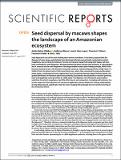Por favor, use este identificador para citar o enlazar a este item:
http://hdl.handle.net/10261/154455COMPARTIR / EXPORTAR:
 SHARE SHARE
 CORE
BASE CORE
BASE
|
|
| Visualizar otros formatos: MARC | Dublin Core | RDF | ORE | MODS | METS | DIDL | DATACITE | |

| Campo DC | Valor | Lengua/Idioma |
|---|---|---|
| dc.contributor.author | Baños-Villalba, Adrián | es_ES |
| dc.contributor.author | Blanco, Guillermo | es_ES |
| dc.contributor.author | Díaz-Luque, José A. | es_ES |
| dc.contributor.author | Denés, Francisco V. | es_ES |
| dc.contributor.author | Hiraldo, Fernando | es_ES |
| dc.contributor.author | Tella, José Luis | es_ES |
| dc.date.accessioned | 2017-08-28T08:54:57Z | - |
| dc.date.available | 2017-08-28T08:54:57Z | - |
| dc.date.issued | 2017 | - |
| dc.identifier.citation | Scientific Reports, 7: 7373(2017) | es_ES |
| dc.identifier.uri | http://hdl.handle.net/10261/154455 | - |
| dc.description.abstract | Seed dispersal is one of the most studied plant–animal mutualisms. It has been proposed that the dispersal of many large-seeded plants from Neotropical forests was primarily conducted by extinct megafauna, and currently by livestock. Parrots can transport large fruits using their beaks, but have been overlooked as seed dispersers. We demonstrate that three macaws (Ara ararauna, A. glaucogularis and A. severus) are the main dispersers of the large-seeded motacú palm Attalea princeps, which is the biomass-dominant tree in the Bolivian Amazonian savannas. Macaws dispersed fruits at high rates (75– 100% of fruits) to distant (up to 1200 m) perching trees, where they consumed the pulp and discarded entire seeds, contributing to forest regeneration and connectivity between distant forests islands. The spatial distribution of immature palms was positively associated to the proximity to macaws’ perching trees and negatively to the proximity to cattle paths. The disperser role of livestock, presumably a substitute for extinct megafauna, had little effect due to soil compaction, trampling and herbivory. Our results underscore the importance of macaws as legitimate, primary dispersers of large-seeded plants at long distances and, specifically, their key role in shaping the landscape structure and functioning of this Amazonian biome | es_ES |
| dc.language.iso | eng | es_ES |
| dc.publisher | Nature Publishing Group | es_ES |
| dc.relation.isversionof | Publisher's version | es_ES |
| dc.rights | openAccess | es_ES |
| dc.title | Seed dispersal by macaws shapes the landscape of an Amazonian ecosystem | es_ES |
| dc.type | artículo | es_ES |
| dc.identifier.doi | 10.1038/s41598-017-07697-5 | - |
| dc.description.peerreviewed | Peer reviewed | es_ES |
| dc.relation.publisherversion | htpp://dx.doi.org/10.1038/s41598-017-07697-5 | es_ES |
| dc.rights.license | Creative Commons Attribution License, | es_ES |
| dc.relation.csic | Sí | es_ES |
| oprm.item.hasRevision | no ko 0 false | * |
| dc.identifier.pmid | 28785083 | - |
| dc.type.coar | http://purl.org/coar/resource_type/c_6501 | es_ES |
| item.openairetype | artículo | - |
| item.fulltext | With Fulltext | - |
| item.openairecristype | http://purl.org/coar/resource_type/c_18cf | - |
| item.cerifentitytype | Publications | - |
| item.grantfulltext | open | - |
| item.languageiso639-1 | en | - |
| Aparece en las colecciones: | (MNCN) Artículos (EBD) Artículos | |
Ficheros en este ítem:
| Fichero | Descripción | Tamaño | Formato | |
|---|---|---|---|---|
| Tella.pdf | 3,23 MB | Adobe PDF |  Visualizar/Abrir |
CORE Recommender
PubMed Central
Citations
11
checked on 26-abr-2024
SCOPUSTM
Citations
59
checked on 09-may-2024
WEB OF SCIENCETM
Citations
55
checked on 26-feb-2024
Page view(s)
273
checked on 12-may-2024
Download(s)
202
checked on 12-may-2024
Google ScholarTM
Check
Altmetric
Altmetric
Artículos relacionados:
NOTA: Los ítems de Digital.CSIC están protegidos por copyright, con todos los derechos reservados, a menos que se indique lo contrario.
